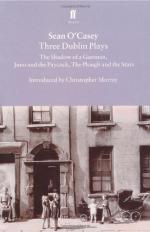|
This section contains 5,146 words (approx. 18 pages at 300 words per page) |

|
SOURCE: “Opening the Eyes of the Audience: Visual and Verbal Imagery in Juno & the Paycock,” in Modern Drama, Vol. XXIX, No. 4, December, 1986, pp. 556-66.
In the following essay, Thomson outlines the delusions about Irish reality and the underlying causes that animate Juno & the Paycock, showing how visual and verbal imagery reinforces a pessimistic interpretation of the play's meaning.
Near the end of Juno and the Paycock, Mary says, “My poor little child that'll have no father!” Juno comforts her, saying, “It'll have what's far betther—It'll have two mothers.”1 Given what we have seen of the men in the play, our initial inclination might be to agree with Juno; however, to do so would be to join the characters in their delusions and to ignore the realities with which O'Casey confronts us. To encourage his audience to see Ireland, and the world, realistically and dispassionately, O'Casey creates a...
|
This section contains 5,146 words (approx. 18 pages at 300 words per page) |

|


